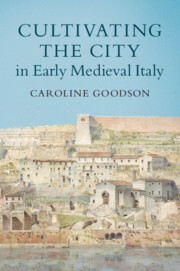Book contents
- Cultivating the City in Early Medieval Italy
- Cultivating the City in Early Medieval Italy
- Copyright page
- Dedication
- Contents
- Figures and Tables
- Acknowledgements
- Terms and Measurements
- Abbreviations
- Additional material
- 1 Urban Gardens and Gardeners
- 2 Patterns and Changes
- 3 The Shape of the Phenomenon
- 4 Alliances and Exchanges
- 5 Values and Ideals
- 6 Conspicuous Cultivation
- 7 Conclusions
- Bibliography
- Index
2 - Patterns and Changes
Published online by Cambridge University Press: 08 March 2021
- Cultivating the City in Early Medieval Italy
- Cultivating the City in Early Medieval Italy
- Copyright page
- Dedication
- Contents
- Figures and Tables
- Acknowledgements
- Terms and Measurements
- Abbreviations
- Additional material
- 1 Urban Gardens and Gardeners
- 2 Patterns and Changes
- 3 The Shape of the Phenomenon
- 4 Alliances and Exchanges
- 5 Values and Ideals
- 6 Conspicuous Cultivation
- 7 Conclusions
- Bibliography
- Index
Summary
Both the urbanism and agriculture of the early Middle Ages broke from the past. A picture of food cultivation and urban density of the cities of Roman Italy is sketched in order to gauge the transformations of late antiquity, which included the reduced population of Italian cities and the fragmentation of urban settlement. The changed urban landscape created possible spaces for food cultivation where there had not been any before. These are apparent in the archaeological record as early as the fifth century and in the textual record in the later sixth century. A key piece of evidence for the transformation of cities is the presence of Dark Earth, humic soil formed in urban contexts after the end of the Roman empire. Dark Earth in Italy is shown here to have been transformed from deposits which were formed deliberately and which underwent a number of different, related processes of waterlogging, accretion, and weathering. The broader economic shape of early medieval Italy, in terms of both regional networks as well as Mediterranean connections, provides a sense of how strategically important urban cultivation became in post-Roman Italy.
Keywords
- Type
- Chapter
- Information
- Cultivating the City in Early Medieval Italy , pp. 32 - 75Publisher: Cambridge University PressPrint publication year: 2021

